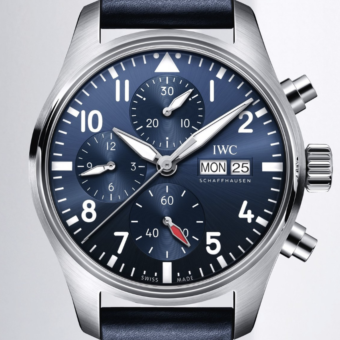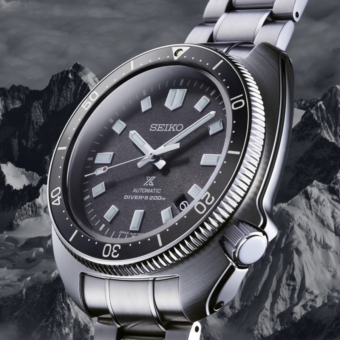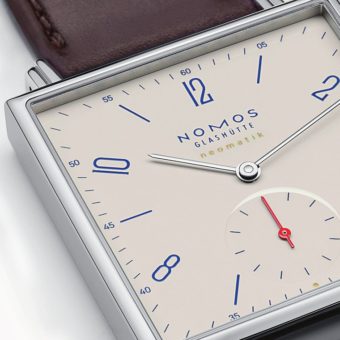This article was originally published in the January/February 2022 Issue of the WatchTime print magazine.
In 2018, Nomos Glashütte equipped its classic Tangente with an intelligent date display called “update.” We tested the new midnight blue model to find out whether the in-house date indicator is just an update or a genuine upgrade.
In the past, the Nomos Tangente Datum was a handwound watch with a date display in a window at 6 below the seconds subdial. If you wanted to adjust the date, you had to turn the hands forward, orbit after orbit, until the correct date appeared in the window. This was tiresome, even if you knew the trick of only moving the hands forward from about 9 p.m. to midnight and then back again. That model, which is no longer manufactured, was replaced in 2018 by a watch equipped with then-new in-house hand-wound Caliber DUW 4101. The date display is still positioned at the 6, but now it’s larger and can be adjusted both forward and backward by using the crown.
Also in 2018, Nomos presented the Tangente Neomatik 41 Update, which is now followed by an even more elegant version with a dark blue dial. The new model also features Nomos’s patented date indicator, but in a completely different design variation — there is no date window, or more accurately, 31 of them. One pair of these little windows flanks the current date on an unobtrusive scale along the edge of the dial. The date disk below the face of the Tangente Neomatik 41 Update Midnight Blue is neon green and glows in the dark.
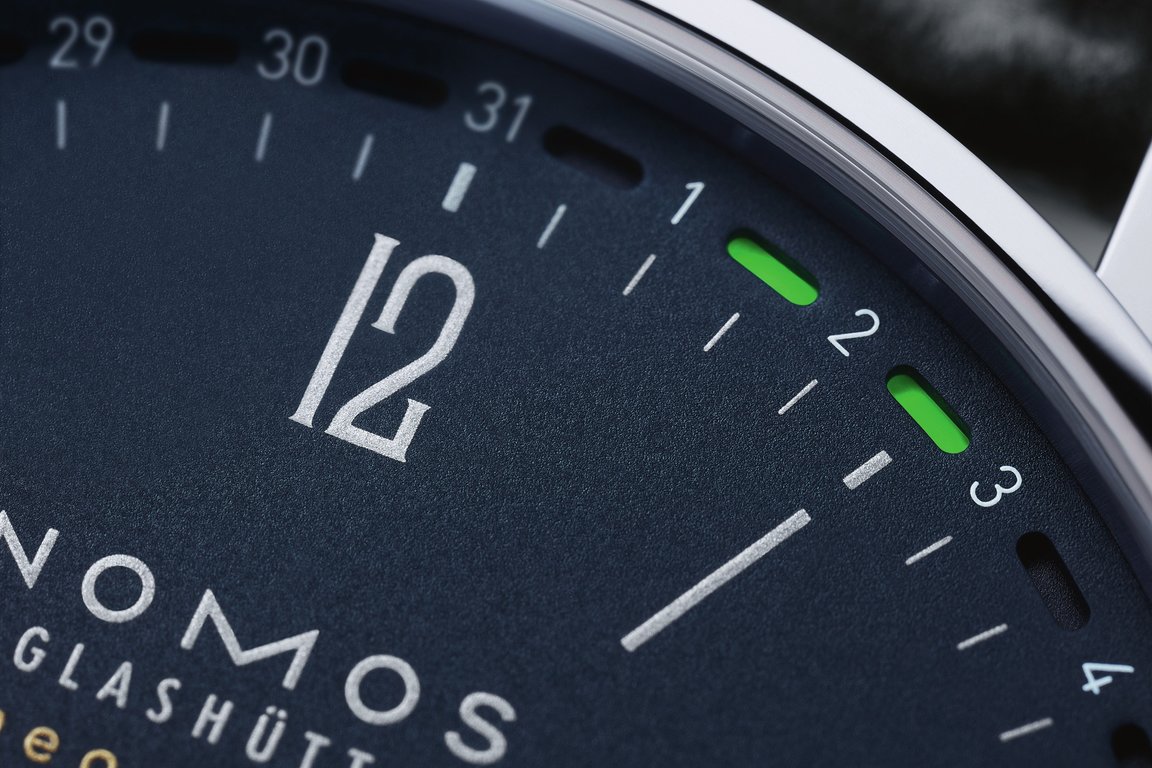
This circle of dates eliminates the need for a conventional date window, which intrudes a bit awkwardly into the minimalist design, especially on slim, elegant watches. A conventional date window is admittedly easier to read, but the date is, after all, a secondary function, which justifies the somewhat greater effort needed to read it. For many watch fans, the advantage of not having a date window below the small seconds subdial clearly outweighs the disadvantages of reading a peripheral display. And the convenience of being able to adjust the date in either direction exceeds the functionality of established large-series calibers and the majority of manufacture movements.
A Slim Manufacture Caliber
Nomos has also abandoned a longstanding tradition: the members of the Tangente model family are no longer necessarily hand-wound watches because they encase movements of the new generation, which are identified by the abbreviation DUW, which stands for “Deutsche Uhrenwerke.” This also applies to our test watch, which is powered by automatic Caliber DUW 6101, which has a central rotor that winds the mainspring in both its directions of rotation. Caliber DUW 6101 is 35.2 mm in diameter and only 3.6 mm tall, just like the ETA 2892, for example, yet it nonetheless offers diverse technical refinements, such as its patented dateadjustment mechanism, as well as its balance, which is stably mounted under a bridge.
The oscillating and escapement system with temperature-blued balance spring was developed by Nomos, which presented this innovation under the name “Nomos Swing System” in 2014. Other advantages of the manufacture movement include fine adjustment in six positions instead of the usual five and, among other handsome embellishments, gold-plated relief lettering on the oscillating weight. The only drawback: the balance of this slim movement is finely adjusted not by using an adjusting screw, but by the somewhat inelegant method of directly moving the regulator.
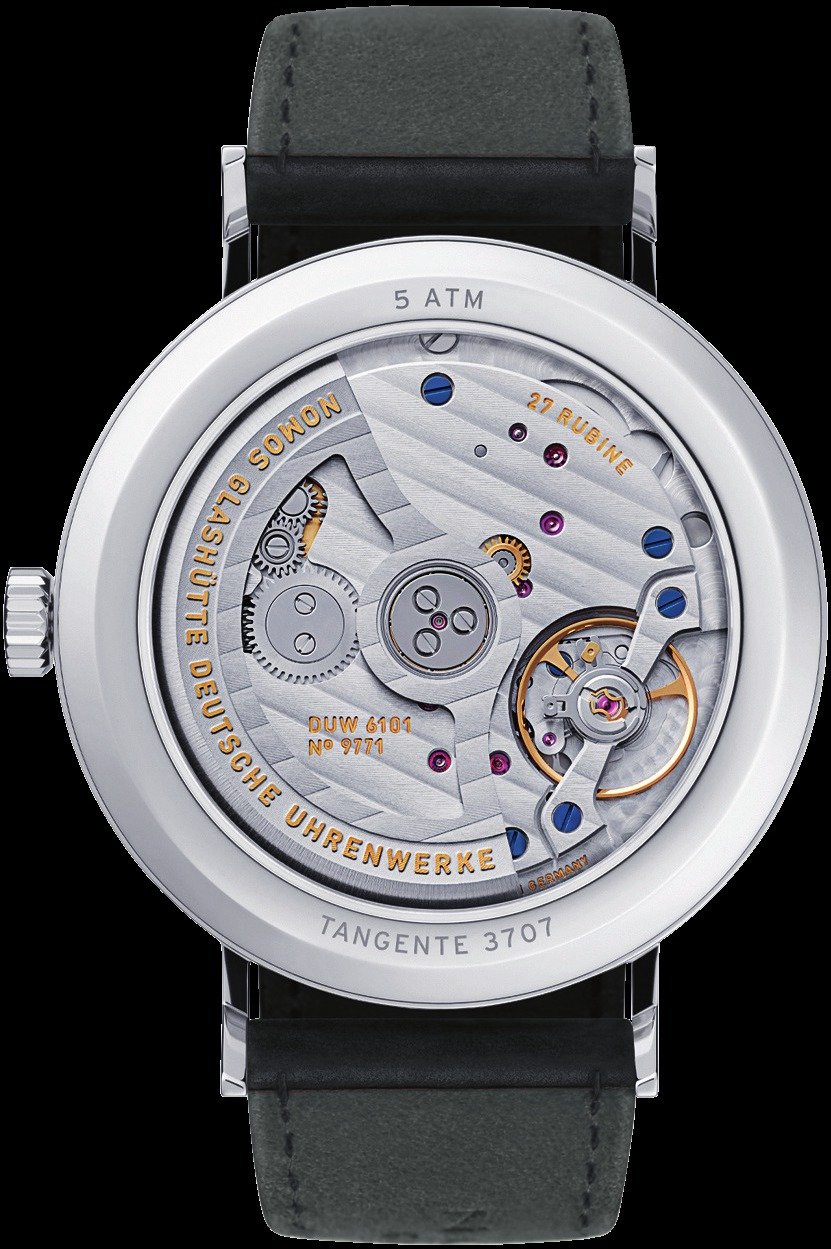
As far as the rate behavior is concerned, our test watch proved to be very reliable. Our timing machine measured a scant average loss of -0.7 second per day. The daily gain during our wearing test, which lasted several weeks, was mostly zero or +1 seconds, but only if the watch was worn around the clock. If it was left lying flat on a dresser overnight and also occasionally during the day, then the gain increased to between 3 and 4 seconds, which is still a very good value. In our strict test regimen, deductions were only made for the significant deviation among the several positions, which was a maximum of 11 seconds.
No matter how pleased you are with the small daily deviation, the look of this new model variant is even more appealing. The combination of a dark blue dial and neon green date fields seems a bit daring, but it adds just the right amount of freshness and individuality to the dial, where all other details are clearly structured as usual, with wellchosen lengths for the hands and neatly balanced proportions. The hands and indexes are not luminous, but this is a tradition at Nomos and it goes well with the simple and elegant Tangente, as does the slimness of all the displays, which slightly reduces legibility but underscores the brand’s origins in the Werkbund and the Bauhaus.
Case and Bracelet
These German schools of design also inspired the austere “pot-shaped” case with its thin, angled lugs. The lugs are sharp on the underside, but this isn’t noticeable when the watch is worn and the timepiece is very comfortable on the wrist. But the sharp edges on the lugs become noticeable after the watch has been taken off and you run your finger over the back. Flat sapphire crystals are integrated into the front and back of the stainless-steel case, which is an ample 40.5 mm in diameter and only 7.8 mm in height. A contradiction? Not at Nomos: the proportions here are just right.
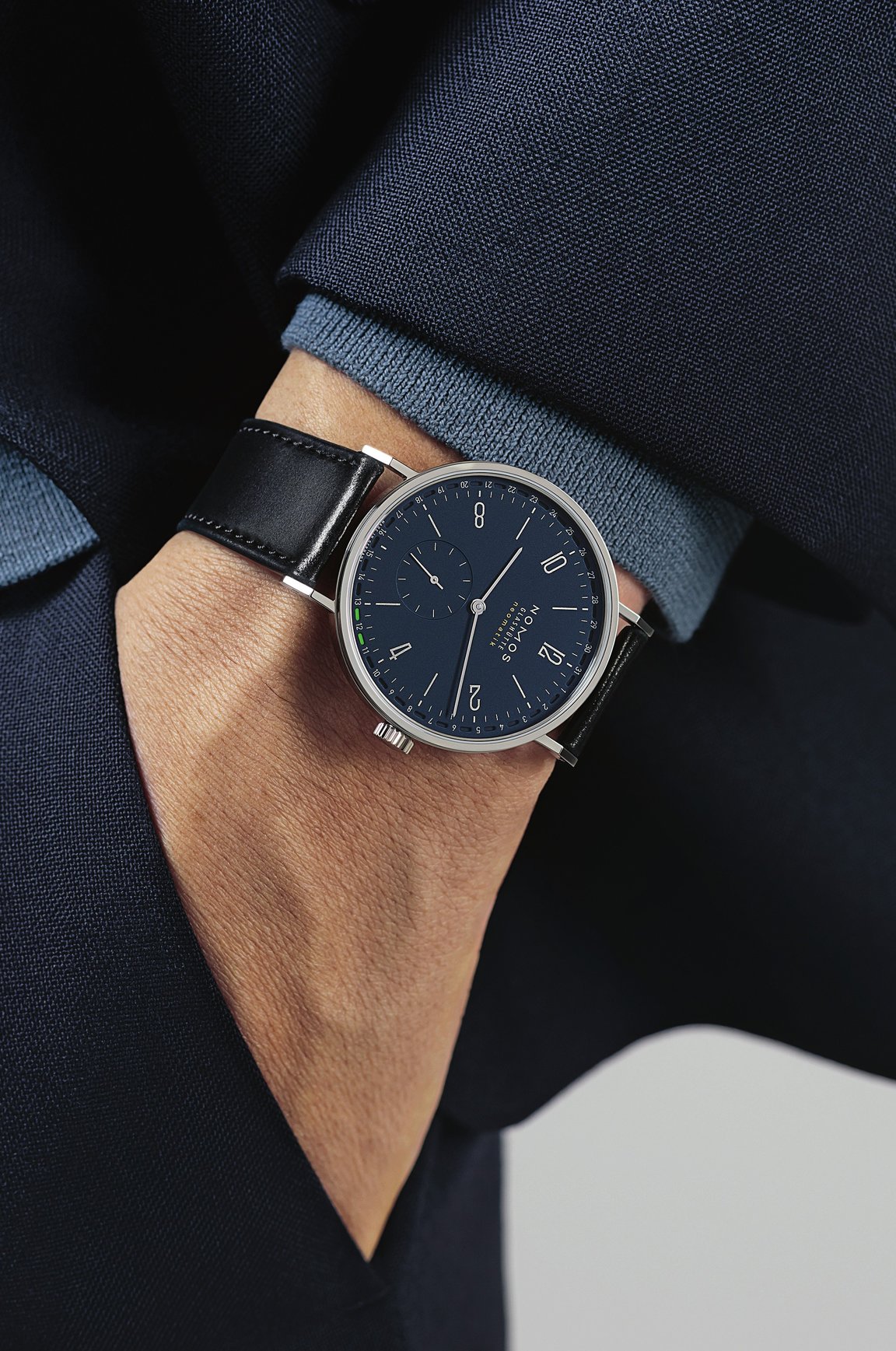
The wristband already underwent a modification that could be called an “update” in 2015, when Nomos eliminated its very simple pin buckle, which was roughly stamped with the brand’s lettering, and replaced it with a finer, cleanly polished “wing buckle.” The previous model already had a clasp that was milled from a solid block of metal, but the overall quality of the buckle is now significantly higher, including the very evenly engraved lettering of the brand’s name on the wider part of the buckle.
The wristband itself is still made of “Horween Genuine Shell Cordovan” horsehide, but it no longer has simple cut edges. The upper leather is now bent under the lower leather and sewn into place. What remains is the deliberately rough and irregular appearance of the lower leather and, unfortunately, also the susceptibility of the upper leather to scratches, abrasion and crease marks caused by threading the strap through the buckle. Close scrutiny of our test watch discovered that the loose leather loop through which the protruding end of the strap can be threaded was roughly sewn and glued to the lower leather.
We’ve noticed these details before in our tests of Nomos watches. The fact that the company stays with its special leather straps seems to suggest that most watch aficionados like them — or at least don’t dislike them. But we find this a bit disappointing for a watch that sells for $4,100.
Be that as it may, we can now return to the question that we posed at the beginning of this article: Is this model an update or an upgrade? The answer is definitely the latter. Nomos has significantly improved the Tangente with date display with its new generation of calibers and has achieved a more harmonious dial design by dispensing with a single large date window. Victory all along the line — it’s a genuine upgrade.
Nomos Glashütte Tangente Neomatik 41 Update Midnight Blue Specs
Manufacturer: Nomos Glashütte/SA Roland Schwertner KG, Ferdinand-Adolph-Lange-Platz 2, D-01768 Glashütte, Germany
Reference number: 182
Functions: Hours, minutes, seconds on a subdial, peripheral date
Movement: Manufacture Caliber DUW 6101, automatic, 21,600 vph, 27 jewels, stop-seconds function, quickset date is adjustable in both directions, Incabloc shock protection, fine adjustment via regulator, 42-hour power reserve, diameter = 35.2 mm, height = 3.6 mm
Case: Stainless-steel case, flat sapphire crystal with antireflective coating on its underside, snap-fit caseback with pane of sapphire crystal, water resistant to 50 m
Strap and clasp: Horsehide strap with stainless-steel pin buckle
Rate results: Deviation in seconds per 24 hours
Dimensions: Diameter = 40.5 mm, height = 7.8 mm, weight = 55 g
Variations: With silver-white dial (Ref. 180, $4,100); with ruthenium dial (Ref. 181, $4,100)
Price: $4,100
Scores:
Strap and clasp (max. 10 points):
We like the new clasp and the wrap-around edges of the wristband, but the upper surface of the horsehide strap is still prone to scratches, abrasion and crease marks from being threaded through the clasp. 7
Case (10): Nomos uses a decidedly simple case with a simple pressure-fitted back and two flat sapphire crystals. The strap lugs are sharp-edged on the underside. 7
Dial and hands (10): The watch’s face is neatly crafted. 8
Design (15): Harmonious proportions, elegant shapes and handsome color scheme, carefully integrated date display — all in all, a well-designed watch. 13
Legibility (5): The well-chosen lengths for the hands and the sensible calibrated scales are offset by low contrast and very slim hands and indexes, which detract from the legibility. To harmonize with the design, the date scale is printed in very small type. 3
Operation (5): The crown clearly clicks into its two pulled-out positions and the date emits a solid “click” when it’s manually advanced. The ability to reset the date in either direction is a major advantage. 5
Wearing comfort (5): This slim wristwatch weighs only 55 grams and sits perfectly on your wrist at all times. 5
Movement (20): Automatic Caliber DUW 6101 is slim and attractively decorated. It also offers a functional date mechanism and a stable balance wheel installed under a sturdy bridge. Fine adjustment by directly moving the regulator is a less appealing detail. 15
Rate results (10): The daily deviation is a very small loss of -0.7 second. The only drawback is a significant maximum deviation of 11 seconds among the several positions. 7
Overall value (10): The exterior is simple, but $4,100 is a good price for a harmoniously designed manufacture watch. 8
TOTAL: 78 points
To learn more about Nomos Glashütte, click here, and to subscribe to the WatchTime print magazine, click here.




